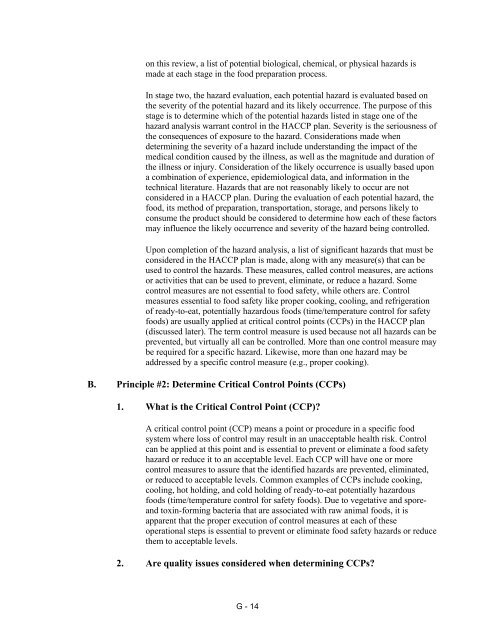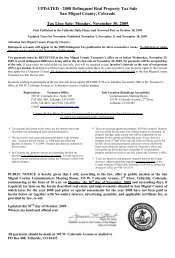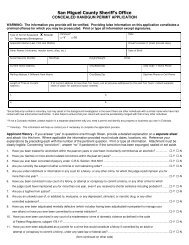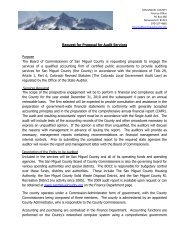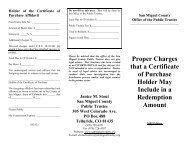colorado retail food establishment rules and ... - Boulder County
colorado retail food establishment rules and ... - Boulder County
colorado retail food establishment rules and ... - Boulder County
Create successful ePaper yourself
Turn your PDF publications into a flip-book with our unique Google optimized e-Paper software.
on this review, a list of potential biological, chemical, or physical hazards is<br />
made at each stage in the <strong>food</strong> preparation process.<br />
In stage two, the hazard evaluation, each potential hazard is evaluated based on<br />
the severity of the potential hazard <strong>and</strong> its likely occurrence. The purpose of this<br />
stage is to determine which of the potential hazards listed in stage one of the<br />
hazard analysis warrant control in the HACCP plan. Severity is the seriousness of<br />
the consequences of exposure to the hazard. Considerations made when<br />
determining the severity of a hazard include underst<strong>and</strong>ing the impact of the<br />
medical condition caused by the illness, as well as the magnitude <strong>and</strong> duration of<br />
the illness or injury. Consideration of the likely occurrence is usually based upon<br />
a combination of experience, epidemiological data, <strong>and</strong> information in the<br />
technical literature. Hazards that are not reasonably likely to occur are not<br />
considered in a HACCP plan. During the evaluation of each potential hazard, the<br />
<strong>food</strong>, its method of preparation, transportation, storage, <strong>and</strong> persons likely to<br />
consume the product should be considered to determine how each of these factors<br />
may influence the likely occurrence <strong>and</strong> severity of the hazard being controlled.<br />
Upon completion of the hazard analysis, a list of significant hazards that must be<br />
considered in the HACCP plan is made, along with any measure(s) that can be<br />
used to control the hazards. These measures, called control measures, are actions<br />
or activities that can be used to prevent, eliminate, or reduce a hazard. Some<br />
control measures are not essential to <strong>food</strong> safety, while others are. Control<br />
measures essential to <strong>food</strong> safety like proper cooking, cooling, <strong>and</strong> refrigeration<br />
of ready-to-eat, potentially hazardous <strong>food</strong>s (time/temperature control for safety<br />
<strong>food</strong>s) are usually applied at critical control points (CCPs) in the HACCP plan<br />
(discussed later). The term control measure is used because not all hazards can be<br />
prevented, but virtually all can be controlled. More than one control measure may<br />
be required for a specific hazard. Likewise, more than one hazard may be<br />
addressed by a specific control measure (e.g., proper cooking).<br />
B. Principle #2: Determine Critical Control Points (CCPs)<br />
1. What is the Critical Control Point (CCP)?<br />
A critical control point (CCP) means a point or procedure in a specific <strong>food</strong><br />
system where loss of control may result in an unacceptable health risk. Control<br />
can be applied at this point <strong>and</strong> is essential to prevent or eliminate a <strong>food</strong> safety<br />
hazard or reduce it to an acceptable level. Each CCP will have one or more<br />
control measures to assure that the identified hazards are prevented, eliminated,<br />
or reduced to acceptable levels. Common examples of CCPs include cooking,<br />
cooling, hot holding, <strong>and</strong> cold holding of ready-to-eat potentially hazardous<br />
<strong>food</strong>s (time/temperature control for safety <strong>food</strong>s). Due to vegetative <strong>and</strong> spore<strong>and</strong><br />
toxin-forming bacteria that are associated with raw animal <strong>food</strong>s, it is<br />
apparent that the proper execution of control measures at each of these<br />
operational steps is essential to prevent or eliminate <strong>food</strong> safety hazards or reduce<br />
them to acceptable levels.<br />
2. Are quality issues considered when determining CCPs?<br />
G - 14


